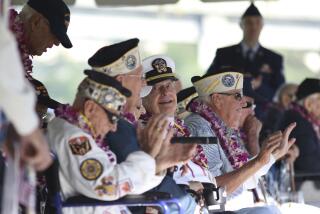Brig. Gen. Frederick Payne Jr. dies at 104; Marine fighter ace in WWII
One day after Japan attacked Pearl Harbor in 1941, Fritz Payne’s Marine unit headed to sea on the aircraft carrier Saratoga.
Within a year, Payne flew into the elite ranks of American aces — fighter pilots who downed at least five enemy aircraft.
Payne died of natural causes at his Rancho Mirage home Thursday, a week after turning 104. He was the oldest living ace, according to Arthur Bednar, coordinator of the Seattle-based American Fighter Aces Assn.
A career Marine, Payne retired in 1958 with the rank of brigadier general. He later worked for Southern California Edison, building a helicopter division that monitored power lines and electrical facilities from the air.
But it was in two weeks at Guadalcanal that he built his lifelong reputation.
“Throughout that strenuous period when the island airfield was under constant bombardment and our precarious ground positions were menaced by the desperate counter thrusts of a fanatical foe, Major Payne repeatedly patrolled hostile territory and intercepted enemy bombing flights,” a Marine citation read. “In five vigorous fights against tremendous odds, (he) shot down a total of six Japanese planes.”
Officially, Payne was credited with 51/2 kills because one of them was in collaboration with another U.S. airman.
He later said his closest call occurred when, stricken with malaria, he threw up into his oxygen mask and passed out. By the time he regained his senses, his plane had plummeted thousands of feet, but he managed to land safely.
In May, the nation’s 1,442 aces, living and dead, were honored in Washington with the Congressional Gold Medal — the highest civilian award given by Congress. Payne, like many of the other 71 survivors, was too frail to attend.
He received his medal closer to home, at a Memorial Day ceremony arranged by the Palm Springs Air Museum.
“It meant everything to him,” his son Robert said.
Payne never made a big point of talking about his experiences.
“Just looking around our house, you’d never know it,” Robert Payne said. “There wasn’t even a military picture on the wall.”
Born in Elmira, N.Y., on July 31, 1911, Frederick Rounsville Payne Jr. was the son of a Navy officer who served in the Spanish-American War. He attended Culver Military Academy in Indiana and the U.S. Naval Academy, which he left after two years. Payne joined the Marines after graduating from the University of Arizona in 1935.
In addition to Guadalcanal, Payne saw combat at Kwajalein, Hollandia (now Jayapura, Indonesia) and Guam. He was made a lieutenant colonel in 1943, and later served in Korea.
In his post-military career, Payne helped plan the construction of the San Onofre nuclear power plant. He retired from Southern California Edison in 1976.
Payne’s wife, Dorothy, died in 2011. His survivors include sons Robert Payne and Dewitt Payne; daughter Elizabeth Ann Payne; and three grandchildren.
Twitter: @schawkins
More to Read
Start your day right
Sign up for Essential California for the L.A. Times biggest news, features and recommendations in your inbox six days a week.
You may occasionally receive promotional content from the Los Angeles Times.







